These TS 10th Class Biology Chapter Wise Important Questions 9th Lesson Our Environment will help the students to improve their time and approach.
TS 10th Class Biology Important Questions 9th Lesson Our Environment
1. Mark Questions:
Question 1.
What happens if decomposers are removed from the food web?
Answer:
- If decomposers are removed from the food web, then the biological cycles are not completed.
- If the decomposers are not present in an ecosystem, the remains of the other organisms accumulate.
Question 2.
Observe the following given below. Draw the pyramid of numbers.
Grass – Goat- Man
Answer:

Question 3.
We can’t expect the world without sparrows. So how should be our concern towards their conservation?
Answer:
- Sparrows are useful to control harmful insects like locust which damage food grains.
- Chemical pesticides are the cause for destruction of sparrows and useful insects.
- By using biological methods we can conserve the sparrow population.
![]()
Question 4.
Human being is modifying agriculture lands and lakes into residential areas. What is its effect on Bio-diversity?
Answer:
- Shelter may not be provided for migratory birds.
- Food chain gets disturbed.
- Decrease in the ground water level.
Question 5.
“We can’t imagine the world without insects and birds.” Suggest two methods to conserve them.
Answer:
Methods to conserve insects and birds:
- Avoid indiscriminate usage of pesticides
- Protect the natural habitats of insects and birds.
- Development of bird sanctuaries
- Everyone should follow environmental ethics.
Question 6.
The figure given below represents a food pyramid. Study it and answer the following questions.
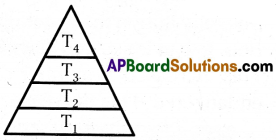
i. Which trophic level has maximum energy?
Answer: T1 (or) Primary producers (green plants)
ii. Give one example for T4 trophic level.
Answer: Lion, tiger, hawk, etc.
Question 7.
How do you protect the plants, which were planted in “Haritha Haaram” programme in your school?
Answer:
We protect the plants:
- Watering of plants at regular intervals.
- Fencing or gaurding of plants.
- Adoption of plants.
- Providing organic mannure.
Question 8.
What is biosphere?
Answer:
The world of living things is called “biosphere”.
(or)
The life supporting zone on the earth is termed as “biosphere”.
Question 9.
What determines the terrestrial ecosystems?
Answer:
The terrestrial ecosystems are being determined largely by the variations in climatic conditions between the poles and equator.
Question 10.
What does a food chain show?
Answer:
A food chain shows who eats what in a particular habitat.
![]()
Question 11.
What is the main source of energy for all the organisms in an ecosystem?
Answer:
Sunlight is the main source of energy for all the organisms in an ecosystem. Sunlight is trapped by the producers and passed to different levels of Consumers through food chain.
Question 12.
What is food web?
Answer:
Food web is the elaborate interconnected feeding relationships in an ecosystem. Many of the food chains in an ecosystem are crosslinked to form food web.
Question 13.
What does a food web indicate?
Answer:
food web suggests a far greater number of possible links for food in an ecosystem and reflects the fact that the whole community is a complex inter-connected unit.
Question 14.
What is ‘niche’?
Answer:
‘Niche’ is the term used to describe the role on organism or population plays within its community or ecosystem.
Question 15.
What does the word ‘niche’ denote?
Answer:
The term ‘niche’ denotes
- The animal’s position in the food web
- What it eats and
- Its mode of life.
Question 16.
What is an ecological pyramid?
Answer:
The graphic representation of the feeding level structure of an ecosystem by taking the shape of a pyramid is called “Ecological pyramid”.
Question 17.
What is pyramid of number?
Answer:
A graphic representation designed to show the number of organisms at each tropic level in a given ecosystem is called “pyramid of number”.
Question 18.
What does the pyramid of number show?
Answer:
Pyramid of number shows the population of organisms at each tropic level in a food chain.
Question 19.
What does each bar represent in a pyramid of number’
Answer:
In a pyramid of number, each bar represents the number of indMd’-ialS at each tropic level in a food chain.
Question 20.
When does the pyramid of number not look like a pyramid at all?
Answer:
The pyramid of number does not look like a pyramid at all
If the producer is a large plant such as a tree or if one of the organisms at any tropic level is very small, then the pyramid of number does not look like a pyramid.
![]()
Question 21.
What is biomass?
Answer:
Biomass is organic material of biological origin that has ultimately derived from the fixation of carbon dioxide and the trapping of solar energy during photosynthesis.
Question 22.
What is biofuel:
Answer:
Biomass used for energy production is called “Biofuel”.
Question 23.
What is pyramid of Biomass?
Answer:
A graphical representation designed to show the quantity of living matter at each tropic level in a given ecosystem is called “Pyramid of Biomass”
Question 24.
Why is pyramid of biomass inverted in case of aquatic ecosystem?
Answer:
In an aquatic ecosystem, the biomass of phytoplankton is quite negligible as compare to that of the crustaceans and small herbivorous fish that feed on these producers.
The biomass of large carnivorous fish living on small fishes is still greater. This makes the pyramid of biomass inverted.
Question 25.
How much percentage of the biomass is transferred from one tropic level to the next in a food chain?
Answer:
Nearly 10- 20% of the biomass is transferred from one tropic level to the next in a food chain.
Question 26.
When does the species at the top of the pyramid get more energy?
Answer:
The species at the top of the pyramid gets more energy, when the steps in a food chain are fewer.
Question 27.
What is ecological efficiency?
Answer:
The ratio between energy flows at different tropic levels among the food chain expressed as percentage is called “ecological efficiency”.
Question 28.
What is Bioaccumu talion?
Answer:
The process of entering of pollutants in a food chain is known as “Bioaccumulation”.
Question 29.
What is Biomagnificalion?
Answer:
The tendency of pollutants to concentrate as they move from one tropic level to the next is known as “Biomagnification”.
Question 30.
What are pesticides?
Answer:
The chemical materials used to control pests that attack crop plants or live as parasites on the body of farm animals are called pesticides.
![]()
Question 31.
What is a perfect pesticide?
Answer:
The perfect pesticide is one which destroys a particular pest and is completely harmless to every other form of life.
No such pesticide exists or likely to.
Question 32.
Who introduced the concept of Ecological pyramids for the first time?
Answer:
The concept of ecological pyramids was first introduced by a British Ecologist Charles Elton in 1927.
Question 33.
How can we draw a food chain?
Answer:
We can draw a food chain by connecting the pictures or names of organisms by putting arrows between them. These arrows should always point from food to the feeder.
Question 34.
How many types of ecological pyramids are there in practice ? Name them.
Answer:
There are three types of ecological pyramids. They are:
- Pyramid of number
- Pyramid of biomass and
- Pyramid of energy.
Question 35
Which process helps to convert solar energy into suitable form of energy for animals to consume?
Answer:
Photosynthesis helps to convert solar energy into suitable form of energy (food) for animals to Consume.
Question 36.
What limits the number of trophic levels in a food chain?
Answer:
There is a loss of energy as we go from one trophic level to the next, this limits the number of trophic levels in a food chain.
Question 37.
State one reason to justify the position of man at the apex of most food chains.
Answer:
The position of man is at the apex of most food chains as he is an Intelligent organism and can take any advantageous position by manipulation.
Question 38.
Which food chains are advantageous in terms of energy?
Answer:
Two step chains in which man is close to producer are advantageous.
For example: Producer – Man
![]()
Question 39.
Construct a food chain composing the following: Snake, Hawk, Rats, Plants.
Answer:
Plants – Rats – Snake – Hawk.
Question 40.
Which of the following will have the maximum concentration of harmful chemicals in its body?
Peacock, Frog, Grass, Snake, Grasshopper.
Answer:
Grass – Grasshopper – Frog – Snake – Peacock
Peacock will have maximum concentration,
Question 41.
Prepare two slogans to conserve water.
Answer:
- A drop of water is worth more than a sack of gold to a thirsty man.
- Don’t let the water run in the sink, our life is on the brink.
Question 42.
By taking two plants of your surroundings as examples, explain how they protect themselves against the animals which eat them.
Answer:
- Neem Tree: Neem leaves contain an alkaloid Nimbin to protect themselves from the animals which eat them.
- Cactus : They have thorns to protect themselves.
- Datura : Datura leaves gives bad odour.
2. Mark Questions:
Question 1.
Explain the flow chart given below.
Answer:
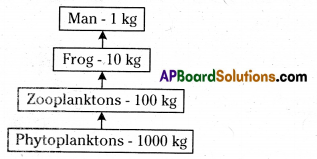
It is the pyramid of biomass.
- In this pyramid 10% of the food will reach to the next trophical level and so on at each level.
- It would take 1000 kg of phytoplankton to provide looking of zooplankton and to form 1kg of human tissue, 10 kg of frog is needed.
- The fewer the steps in the food chain, the more energy will be for the species at the top.
![]()
Question 2.
Observe the pyramid of number which is given below and answer the questions.

i. As per the number of organisms in the tropic level, which group of organisms are more in number and which are less in number?
ii. What happens if Secondary consumers disappear?
Answer:
- If producers are more in number, then tertiary consumers are less in number.
- If secondary consumers disappear the primary consumers increase in number and the tertiary consumers found no food to live. It leads to death.
Question 3.
Explain in brief about the alternate methods to be followed to prevent the harmful effects of over usage of pesticides.
OR
Mention any four effective methods of controlling pests, which are less harmful on environment based on biological principles.
Answer:
Some of alternative pest control methods are
- Rotation of Crop: Growing different crops on a particular piece of land in successive years.
- Studying the life histories of the pests : When this is done it is sometimes possible to sow the crops at a time when least damage will be caused.
- Biological Control : Introducing Natural predator or parasite of the pest.
- Sterility: Rendering the males of a pest species sterile.
- Genetic Strains : The development of genetic strains (genetically modified plants) which are resistant to certain pest
- Environmental ethics: People need to know besides laws regarding environment there are some basic ethics what is right and what is wrong in view of environment.
Question 4.
Write any 4 slogans on the necessity of forests and on their conservation.
Answer:
- Save the trees, save the earth. We are the guardians of nature’s birth.
- Don’t destroy the greenery and don’t spoil the scenery.
- Don’t make trees rare, we should keep them with care.
- To live for future in rest, saving forest is the best.
Question 5.
How do the given below concepts differ?
a. Bioaccumulation
b. Biomagnification
Answer:
a. Bloaccumulation: The process of entry of pollutants into a food chain is known as bioaccumulation.
b. Blomagnification : It is the tendency of pollutants to concentrate as they move from one tropic level to the next is known as biomagnification.
Question 6.
The biomass of a producer in an ecosystem is calculated as 3500 kgs. Calculate the biomass of primary, secondary, tertiary consumers.
Answer:
In a food chain roughly 90% of the food is lost at each step. So if the biomass of a producer in an ecosystem is calculated as 3500 kgs. the biomass of primary consumer as will be 350 kgs. and of secondary consumer is 35 kgs and biomass of tertiary consumer is 3.5 kgs.

Question 7.
Write a short notes on ecological pyramids.
Answer:
- The graphic representation of the feeding level structure of an ecosystem by taking the shape of a pyramid is called “Ecological pyramid”.
- It was first introduced by a British Ecologist Charles Elton in 1927.
- In the ecological pyramid, the producers (First tropic level) are represented at the base, and the successive tropic levels (primary, secondary and tertiary consumers) are represented one above the other with top carnivores at the tip.
- There are three types of pyramids.
i. Pyramid of number,
ii. Pyramid of biomass and
iii. Pyramid of energy. - Pyramid of number shows the population of organisms at each tropic level in a food chain.
- Pyramid of biomass represents the available food as a source of energy at each tropic level in the food chain.
- Pyramid of energy represents the available energy at each tropic level in food chain.
![]()
Question 5.
How do pesticides cause Bioaccumulation and Biomagnification?
Answer:
- Pesticides are the toxic chemicals used to destroy pest and insects which damage our crops and stored foods.
- These pesticides vary in their length of life as toxic materials.
- Some of the pesticides are degradable that can be broken down into harmless substances in a comparatively short time and others are non-degradable.
- Non-degradable pesticides accumulate in the bodies of animal and pass right through food web.
- Thus the pesticides cause bioaccumulation.
- These accumulated pesticides concentrate as they move from one tropic level to the next, thus leads to biomagnification.
Question 6.
List out some human activities which altered the communities of plants and animals in their natural ecosystem.
Answer:
- Industrialization
- Damming rivers
- Draining marshes
- Re-claiming land from the sea
- Cutting down forests
- Using chemical fertilisers and pesticides
- Building towns, cities, canals and motor ways.
Question 7.
What kind of changes may come In an ecosystem due to development of a large town?
Answer:
The following changes are expected due to development of a large town.
- Some plants and animal species will die out.
- Some will adapt to the new conditions sufficiently to survive in reduced numbers.
- Some will benefit by the new conditions and will increase in numbers & Write a comparative note on pyramid of number and pyramid of biomass.
![]()
Question 8.
Write a comparative note on pyramid of number and pyramid of biomass.
Answer:
| Pyramid of number | Pyramid of biomass |
| 1. Pyramid of number is a graphical representation designed to show the number of organisms at each tropic level in a given ecosystem. | 1. Pyramid of biomass is a graphical representation designed to show the quantity of living matter at each tropic level in a given ecosystem. |
| 2. It shows the population of organisms at each tropic level in a food chain. | 2. It represents the available food as a source of energy at each tropic level in the food chain. |
| 3. This pyramid sometimes does not look like a pyramid at all. It may be upright like a grassland ecosystem, partly upright like in forest ecosystem or inverted like in parasitic ecosystem. | 3. This pyramid may be upright like in terrestrial ecosystem or inverted like in aquatic ecosystem. |
4. Mark Questions:
Question 1.
Observe the following diagram and answer the following questions.
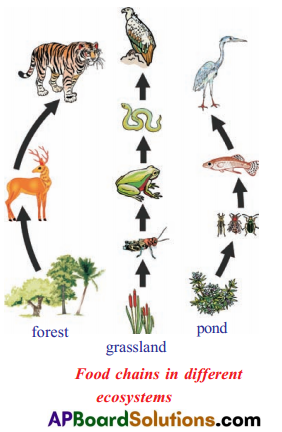
i. Name the primary producers in the given food web.
ii. Prepare any one food – chain from the diagram.
iii. What are the tertiary consumers?
iv. Write names of any two herivores.
Answer:
i. Plants, Grass, Trees Phytoplanktons etc.
ii. Grass → Rabbit → Fox →Tiger
iii. Tiger, Vulture, Crane, Owl, Peacock, etc.
(OR)
The animals which are at 4th trophic level a food chain are called as Tertiary Consumers.
iv. Rabbit, Deer, Goat, Cow.
I. Conceptual Understanding
Question 1.
What is number pyramid? What does it indicate?
Answer:
- The number of organisms in a food chain can be represented graphically in a pyramid of number.
- Each bar represents the number of individuals at each tropic level a food chain.
- At each link in a food chain, from the first order consumers to the large carnivores, there is normally an increase in size but decrease in number.
- For example in a wood. the aphids are very small and occur in astronomical numbers.
- The lady birds which feed on them are distinctly larger and not so numerous.
- The insectivorous birds which feed on the lady birds are larger still and are only present in a small number and there may only be a single pair of hawks of much larger size than the insectivorous birds on which they prey.
![]()
Question 2.
What reasons are responsible for decrease in number of top carnivores and biomass starting production in a food chain?
OR
Why does the number of organisms get decreased as we move from producers to consumer levels?
Answer:
- In a food chain as we move from producers to different levels of consumers the energy available will decrease gradually.
- Only ten percent of the energy present in one tropic level transfer to another tropic level.
- Biomass also decreases gradually as only 10 – 20% of the biomass is transferred from one tropic level to the next in a food chain.
- As there is less energy of less biomass available at top levels, number of organisms also less generally.
- So the number of organisms get decreased as we move from producers to different level of consumer.
Question 3.
What is Ecological pyramid ? Describe different types of Ecological pyramids.
Answer:
The graphic representation of the feeding level structure of an ecosystem by taking the shape of a pyramid is called “Ecological Pyramid. There are three types of ecological pyramids. They are
I. Pyramid of number
II. Pyramid of biomass and
III. Pyramid of energy
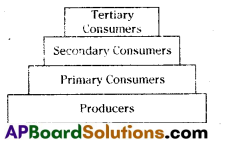
I. Pyramid of Number:
- Pyramid of number is a graphical representation designed to show the number of organisms at each tropic level in a given ecosystem.
- The shape of this pyramid varies from ecosystem to ecosystem.
- In aquatic and grassland ecosystems, numerous small autotrophs support lesser herbivores which support further small number of carnivores and hence the pyramid structure is upright.
- In forest ecosystem, less number of producers support greater number of herbivores who in turn support a fewer number of carnivores. Hence the pyramid structure is partly upright.
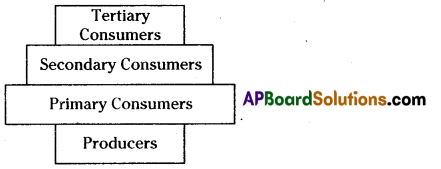
- In parasitic food chain, one primary producer supports numerous parasites which support still more hyperparasites. Hence the pyramid structure is Inverted.

II. Pyramid of Biomass:
1. Pyramid of biomass is a graphical representation designed to show the quantity of living matter (biomass) at each tropic level in a given ecosystem.

2. In terrestrial ecosystems, the biomass progressively decreases from producers to top carnivores. Hence the pyramid structure is upright.
3. In an aquatic ecosystem, the biomass of phytoplankton (producers) is quite negligible as compared to that of crustaceans and small herbivorous fish that feed on these producers. The biomass of large carnivorous fish living on small fishes is still greater. This makes the pyramid of biomass inverted.
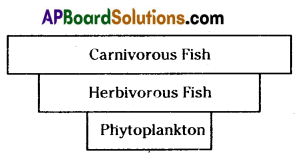
III. Pyramid of Energy:

- Pyramid of energy is a graphical representation designed to show the quantity of energy present at each tropic level in a given ecosystem.
- The quantity of energy available for utilization in successive tropic levels is always less in any ecosystem. This is because there is loss of energy in each transfer. Hence the pyramid of energy is always upright.
Question 4.
What determines the terrestrial ecosystems on the earth?
Answer:
- The terrestrial ecosystems on the earth are being determined largely by the variations in climate conditions between the poles and equator.
- The main climatic influences which determine these ecosystems are rainfall, temperature and availability of light from the sun.
- For instance, forests are usually associated with high rainfall, but the type is influenced by temperature and light.
- The same applies to deserts which occur in regions where rainfall is extremely low.
- Thus, the climatic conditions along the horizontal climatic regions determined the terrestrial ecosystems on the earth.
- If we move from equatorial region to the polar region, we can come across tropical rain forests, savannah, deciduous fórest, coniferous forests and then tundras respectively.
- Similarly altitude of the place is also a determining factor.
- If we climb a mountain such as Kilimanjaro in equatorial Africa, we can go through a comparable system of ecosystems. starting with tropical rain forest at the base and ending with perpetual snow and ice at the summit.
![]()
Question 5.
Write a short note on food chain and food web.
Answer:
- Food chain is a pathway along which food ¡s transferred from one tropic level to another tropic level beginning with producers.
- It shows who eats what in a particular habitat.
- The arrows between each item in the chain always point from the food to the feeder.
- For example Grass → Rabbit → Snake→ Hawk
- The elaborate interconnected feeding relationships in an ecosystem is said to be food web.
- Many of the food chains in an ecosystem are crosslinked to form food web.
- For example,
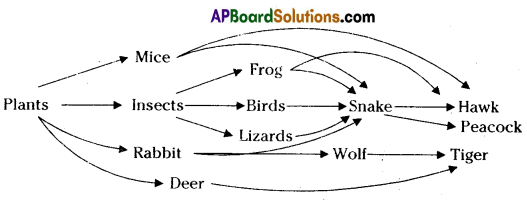
- Food chain and food web help us to understand the food relations among living things.
Question 6.
Which pyramid is always upright? Why?
Answer:
- The pyramid of energy is always upright.
- This is because, only 10% of the energy present in a tropic level transfers to the other level.
- If there are 1000 calories of net production at producer level, only 100 calories of secondary production would be expected at the herbivore level, only 10 calories at level and I calorie at top carnivore level.
- The flow of energy from producers to consumers is unidirectional.
- So energy at producers level is always greater than the energy at primary consumer level and so on.
- Hence the pyramid of energy is always upright with a typical pyramid shape.
- But in case of pyramid of number, number of producers may be less than consumers in some ecosystems or number of primary consumers may be less than secondary consumers, etc. causing inverted or partly upright.
- In case of pyramid of biomass also the pyramid may inverted like in aquatic ecosystem, where the biomass of producers is less than that of consumers.
Question 7.
Why was anti-sparrow army established in 1958 in China?
Answer:
- Rural official overstated the amount of grain for fear of not meeting their Quota to China government.
- This over-reporting led to an imbalance between the demand and supply.
- The sparrows were accused of pecking away at the supplies in warehouses at an officially estimated rate of four Pounds of grain per sparrow per year.
- In the cities and the outskirts, almost half of the labour force was mobilized into the anti-sparrow army.
Question 8.
How did anti-sparrow army eradicate sparrows ? Is it right decision?
Answer:
- People started trapping, poisoning and killing sparrows in large numbers.
- Several free-fire zones were set up for shooting the sparrows.
- People would beat drums to scare the birds from cauding, so the sparrows were forced to keep flying until they dropped dead from fatigue.
- Sparrow nets were torn down, eggs were broken and nestlings were killed.
- Non-material rewards and recognition were offered to schools, work units and government agencies in accordance with the number of sparrows killed.
- No, it is not right decision Later years they come to know that decision of killing sparrows is wrong.
![]()
Question 9.
Were the sparrows really responsible for decrease in production ?How did they come to know it?
Answer:
- No, the sparrows really not responsible for decrease in production.
- Later some scientists who cut open the digestive systems of dead sparrows found that 3/4th of the contents were of insects harmful (or crops and only 1/4th contained grains.
Question 10.
Write some effective methods of controlling pests which have far less harmful effects and are based on sound biological principles. It is easy to say “Ban all pesticides” but the pests still have to be kept in check. How do you justify this statement?
Answer:
Some important effect biological pest controlling methods are:
- Rotation of crops: Growing different crops on particular piece of land in succession near reduces the pest on crops.
- Studying the life histories of the pest : When this is done it is sometimes possible to sow the crops at a time when least damage will be caused.
- Biological control : Introducing natural predators.
- Sterility: Rendering the males of a pest species sterile.
- Genetic strain : The development of genetic strains which are resistant to certain pest.
- Environment ethics: This is concerned with morality of human activities as they affect the environment. People need to know besides laws regarding environment. There are some basic ethics, what is right and what is wrong in view of environment.
IV. Information Skills And Projects
Question 1.
Collect information regarding pesticides commonly used in your area and prepare a chart showing pesticide and common name and on which crop and pest it is commonly used.
Answer:

V. Communication Through Drawing, Model Making:
Question 1.
Draw the diagram of number pyramid keeping foxes as third consumers. What are the consequences if their number increases?
Answer:
- If the number of foxes increases, then the complete Foxtion for food will be very severe and less amount of food will be available for them.
- As a result some of the foxes may not get enough food and die due to starvation.

- This reduces the population of foxes and very few foxes will be left in the forest.
- This increases the chances of survival of secondary consumers birds, hence their number increases.
- This increases the availability of food for foxes. Very soon a balance will be established between the number of secondary consumers and foxes.
![]()
Question 2.
Show food chain of different organisms, number of pyramid of your school.
Answer:
Food chain of different organisms in our school:
Plant aphids → spiders → birds.
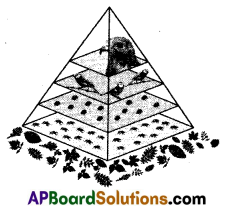
- The pyramid of organisms in a food chain can be represented graphically in a pyramid of number.
- Each bar represents the number of individuals at each tropic level in a food chain.
- At each link in a food chain, from the first order consumers to the large carnivores, there is normally an increase in size, but decrease in number.
Question 3.
Draw a flow chart to describe the process of bioaccumulation and biomagnification of toxic pesticides In the body of eagles.
Answer:
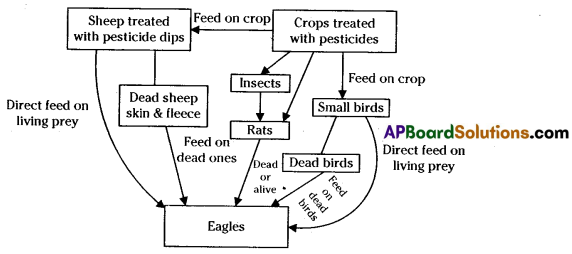
Question 4.
Draw the ecological pyramids for the given food chain.
Banyan tree → Herbivorous birds → Carnivorous birds.
Answer:
1. Pyramid of number
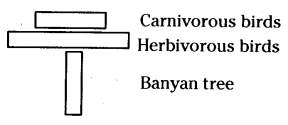
2. Pyramid of biomass

3. Pyramid of energy
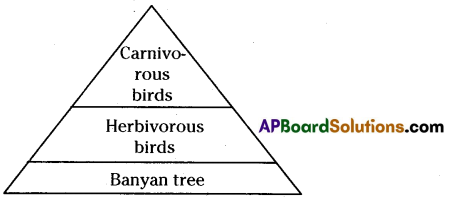
VI. Appreciation And Aesthetic Sense, Values
Question 1.
In a grassland ecosystem, some students are frying to kill the grasshoppers for fun. You don’t like this. How do you convince your friends not to do so?
Answer:
1. I will convince my friends to stop killing grasshoppers by explaining them about the food chain.
2. In grassland ecosystem grasshoppers are present at primary consumer level as shown hereunder.
Grass → Grasshopper → Frogs → Snake.
3.In grassland ecosystem frogs depend on grasshoppers for food. 1f students kill the grasshopper, the frogs die due to lack of food.
4. This shows a great impact on the snakes which depend on frogs for food. Every living organism on earth has right to live. We must respect other creatures on the earth.
5. So if grasshoppers are killed, it disturbs the food chain to a greater extent. Hence I advise my friends not to kill grasshoppers.
VII. Application To Daily Life, Concern To Biodiversity
Question 1.
Write what friendly ecosystem activities you will conduct in your school.
Answer:
1. Forming eco dubs: These clubs consists of student representatives from each class. They will take up the eco-friendly activities and encourage the people of that village to follow environment friendly activities.
2. Settling up garden at school : This ensures the school and its premises green through planting of flowering plants, vegetables and fruit trees. It is a symbol of biodiversity because various plants and animals inhabit the garden.
3. Electricity conservation programme : To save energy the school implements certain hours to be switched off habit. This switching off programme for one hour from 3.30 p.m. to 4.30 p.m. help conserve electricity in every class room.
4. Pollution prevention programme : A ‘no burning of trash’ policy should be implemented in the school. Waste materials are recycled and properly disposed to ensure a clean, waste-free environment.
![]()
5. Making compost by organic wastes: By digging a pit at one corner of the school and throwing the organic waste, particularly of mid-day meal waste into pit and covering with soil layers prepares compost which can be used as manure for plants. This creates a clean environment in the school.
6. Using cloth bags instead of polythene bags by pupil.
7. Collection of solid waste materials and proper management of its helps in reducing soil pollution.
8. Children should be encouraged to follow ‘3R’ system i.e. Reduce, Reuse and Recycle different substances.
Question 2.
If we introduce a man into a forest ecosystem, at which level of food chain we will place him? Explain your answer.
Answer:
- If we introduce a man into a forest ecosystem, he can fit for any level of Consumers of food chain.
- He may feed on plant parts such as fruits. Then we can place him at primary consumer level. Plant → Man
- He may feed on some of the herbivorous organisms such as rabbit, then we can place him at secondary consumers level. Plant → Rabbit → Man
- He may also feed on some of the carnivorous organisms such as insectivorous birds then we can place him at tertiary consumers level. Plant → Insect → Bird → Man
- This is possible to place him at any level of consumers, as he is an omnivore, who feed on both plant originated and animal originated foods.
Question 3.
‘All the energy in the ecosystem is ultimately derived from sunlight. “Justify.
Answer:
- All the organisms in an ecosystem derive energy from food.
- The food by its nature is the chemical energy and by in its stored form, it is the potential energy.
- In an ecosystem, all the consumers at any level depend upon producers for their food either directly or indirectly.
- The producers in any ecosystem are nothing but photosynthètic organisms such as plants, phytoplanktons and photosynthetic bacteria.
- Energy enters the producers in the ecosystem from the sun in the form of solar energy during photosynthesis.
- From the producers, the chemical energy passes to the consumers from the tropic level to the next through food.
- For example in a grassland ecosystem, grass traps the solar energy and stores in its body.
- When this grass is eaten and assimilated by insects this stored energy enters into the body of insects.
- From the insects it will pass to frog, from them to snake and so on to eagle.
- Thus, all the energy in the ecosystem is ultimately derived from sunlight.
![]()
Question 4.
Howaresparrows really helpful to farmers in China?
Answer:
- After anti-sparrow campaign, some scientists cut open the digestive systems of dead sparrows found 3/4 of contents were insects and 1/4 of contents contained grains.
- These sparrows are very useful in eradition of harmful insects in feuds and improve yielding.